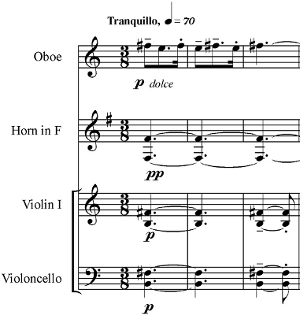Concerto for Orchestra (Bartók) facts for kids
The Concerto for Orchestra is a famous piece of music written for a large group of instruments called an orchestra. It was created by a Hungarian composer named Béla Bartók. This piece is one of the most well-known orchestral works from the middle of the 20th century.
Usually, a concerto is a special piece where one instrument (like a piano or violin) plays a solo part with the orchestra. But in a "Concerto for Orchestra," there isn't just one soloist. Instead, many different instruments in the orchestra get a chance to play important, solo-like parts. This is why Bartók called his piece a "Concerto for Orchestra" instead of a symphony.
Bartók wrote this music in 1943. It was first played on December 1, 1944, in Boston by the Boston Symphony Orchestra. The conductor was Serge Koussevitzky. The piece was a huge success right away! Koussevitzky had asked Bartók to write it. Bartók had just moved to the United States from Hungary because of World War II. He didn't have much money, so he was happy to get this work.
Contents
The Music of the Concerto
Bartók often used ideas from classical music in this piece. He also added sounds from folk music, especially from central Europe and Hungary. Sometimes, the music doesn't sound like it's in a normal major or minor key. Instead, Bartók used folk scales, which have different kinds of sounds called modes. Some parts sound just like folk tunes. Other times, you might hear long, steady notes called drones played by the horns and strings.
Instruments in the Orchestra
To play this concerto, the orchestra needs many different instruments. Here's what Bartók used:
- 3 flutes (one can also play piccolo)
- 3 oboes (one can also play cor anglais)
- 3 clarinets (one can also play bass clarinet)
- 3 bassoons (one can also play contrabassoon)
- 4 French horns
- 3 trumpets
- 3 trombones
- 1 tuba
- timpani (kettledrums)
- side drum
- bass drum
- cymbals
- triangle
- tamtam (a large gong)
- 2 harps
- The strings (violins, violas, cellos, and double basses)
The Five Movements
The Concerto for Orchestra has five main parts, which are called movements. Each movement has its own special feeling and sound.
First Movement: Introduzione
Bartók called the first movement Introduzione, which means "Introduction." It starts slowly and sounds a bit mysterious, like music describing the night. Bartók often created this kind of "night music" in his pieces. This movement is built in a style called sonata form.
Second Movement: "Giuoco delle coppie"
The second movement is called "Giuoco delle coppie," which means "Game of Pairs." In this part, different pairs of instruments take turns playing a tune. Each pair plays music that is separated by a different musical interval, making it sound like they are having a playful conversation.
Third Movement: Elegia
The third movement is called Elegia, meaning "Elegy." This is another slow and thoughtful movement. It's another example of Bartók's unique "night music" style, often sounding a bit sad or reflective.
Fourth Movement: Intermezzo interrotto
The fourth movement is named Intermezzo interrotto, which means "Interrupted Intermezzo." It has a smooth, flowing melody, but the time signature (the rhythm pattern) keeps changing, which makes it sound interesting and unpredictable. There's also a part that playfully makes fun of a march tune from another famous piece, Dmitri Shostakovich's "Leningrad" Symphony. The timpani player has a very tricky section where they have to play many different pitches very quickly.
Fifth Movement: Finale
The fifth and final movement is simply called Finale. It's a very fast and energetic part of the concerto. It's full of lively folk tunes and has a lot of excitement, bringing the piece to a powerful end.
See also
 In Spanish: Concierto para orquesta (Bartók) para niños
In Spanish: Concierto para orquesta (Bartók) para niños


